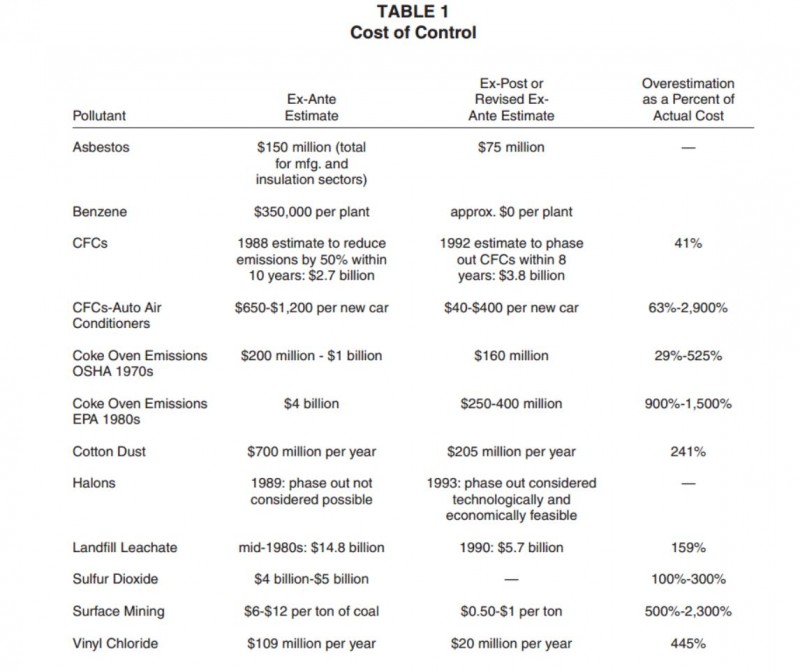Reducing Carbon Emissions Will Be Cheaper Than Expected – It Always Is
With the announcement of EPA’s proposed cuts to carbon emissions from existing powerplants, there’s already tremendous argument about how much they’ll cost. Some will argue that they’ll destroy the economy. How has that argument worked out in the past?
To those claiming new climate regulations will destroy the economy, here’s how past claims panned out. pic.twitter.com/h10THSnN1E
— Peter Gleick (@PeterGleick) June 1, 2014
Not so well.
History tells us that pollution reductions are almost always cheaper than projected, even by the EPA. I wrote about this in The Infinite Resource. Here’s a slightly modified excerpt:
—
Ozone / CFCs
In the late 70s, DuPont’s Chairman of the Board had asserted that any connection between CFCs and ozone depletion was “science fiction.” The company warned in the 80s that phasing out CFCs could cost the US more than $130 billion and that “entire industries could fold.”[i]
The EPA expected the phase-out to cost a total of $28 billion to the US economy.
At a Congressional hearing, a representative of the Air-Conditioning and Refrigeration Institute (an industry lobbying group) testified that, if CFCs were phased out on the proposed schedule, “We will see shutdowns of refrigeration equipment in supermarkets. … We will see shutdowns of chiller machines, which cool our large office buildings, our hotels, and hospitals.”[iii] As late as 1994, the Competitive Enterprise Institute was claiming that phasing out CFCs would cost the country between $45 billion and $99 billion.[iv]
According to an analysis by the Economic Policy Institute, the actual cost across the entire US economy turned out to be less than $10 billion.[v] And the country’s air conditioning and refrigeration kept on working without disruption.
$10 billion is less than a tenth of what DuPont estimated linkbuildingservices.uk, less than a quarter of the lowest end of the cost estimates from the Competitive Enterprise Institute, and only slightly more than a third of what the EPA itself estimated.
Benzene
In the 1970s, when the EPA began to put limits on the amount of cancer-causing benzene that could be released, chemical companies forecast that it would cost $350,000 per plant to install equipment to meet the new targets. A few years later, new processes that eliminated benzene entirely reduced the cost to zero.
Non-Freon Air Conditioning in Cars
During the CFC phase-out debate, US automakers predicted that it would cost $650 – $1200 per car to fit new vehicles with air conditioners that didn’t use Freon. In 1997, the cost was estimated at between $40 and $400 per car, less than a third of the initial projections.
Asbestos
In the 1970s, OSHA, the Occupational Health and Safety Administration, estimated that ending the use of Asbestos in manufacturing and insulation would cost $150 million. A few years later, the cost was found to be half that, at $75 million.
Steel Coke Ovens
In 1987, the EPA estimated that reducing air pollution from the steel industry’s coke ovens (where coal is cooked as part of the process of making steel) would cost $4 billion. By 1991, experience had dropped the cost estimate to less than $400 million, a ten times reduction.
Everywhere we look, the cost of reducing either resource use or pollution drops through innovation. Even the cost estimates of regulators turn out to be too high. And necessity – or profit – is the mother of innovation.
—
EPI has an excellent research paper on this topic. Recommended reading. Here is a key table showing how, time and again, pollution reductions are dramatically cheaper than expected:
[i] Masters, Jeffrey. “The Skeptics vs. the Ozone Hole.” Wunderground.com, . http://www.wunderground.com/resources/climate/ozone_skeptics.asp
[ii] Whittemore, Jessica. “Reagan and the Montreal Protocol: Environmentalism at its Unlikely Finest.” The Presidency, 2008. http://www.thepresidency.org/storage/documents/Fellows2008/Whittemore.pdf
[iii] Cry Wolf Project, “Industry Claims About the Clean Air Act.” June 16th 2009. Accessed March 7, 2012. http://crywolfproject.org/quotes/quote-–-air-conditioning-and-refrigeration-institute-house-committee-energy-and-commerce.
[iv] Lieberman, Ben. “The High Cost of Cool: The Economic Impact of the CFC Phaseout in the United States.” Competitive Enterprise Institute, June 1994. http://cei.org/studies-issue-analysis/high-cost-cool-economic-impact-cfc-phaseout
[v] Hodges, Hart. “Falling Prices; Cost of Complying With Environmental Regulations Almost Always Less Than Advertised.” Economic Policy Institue, 1990. http://www.epi.org/page/-/old/briefingpapers/bp69.pdf


